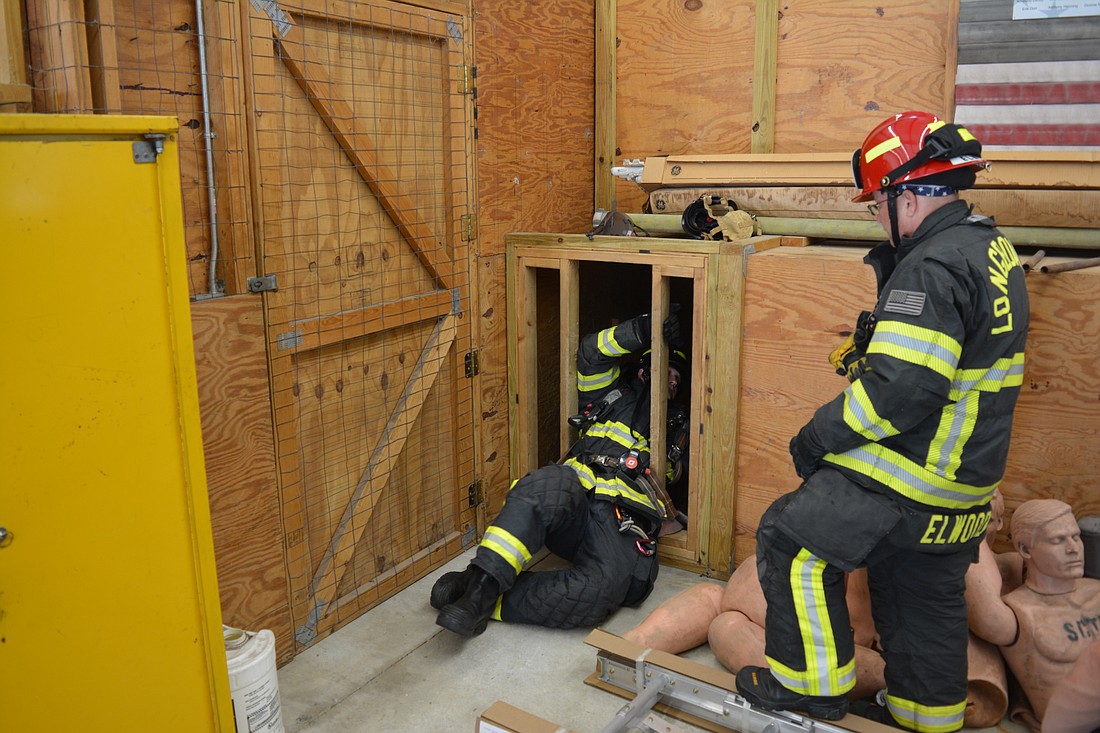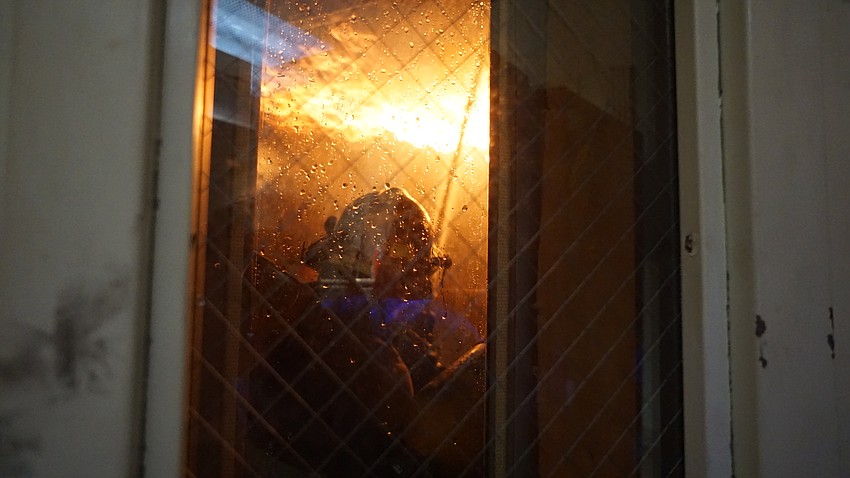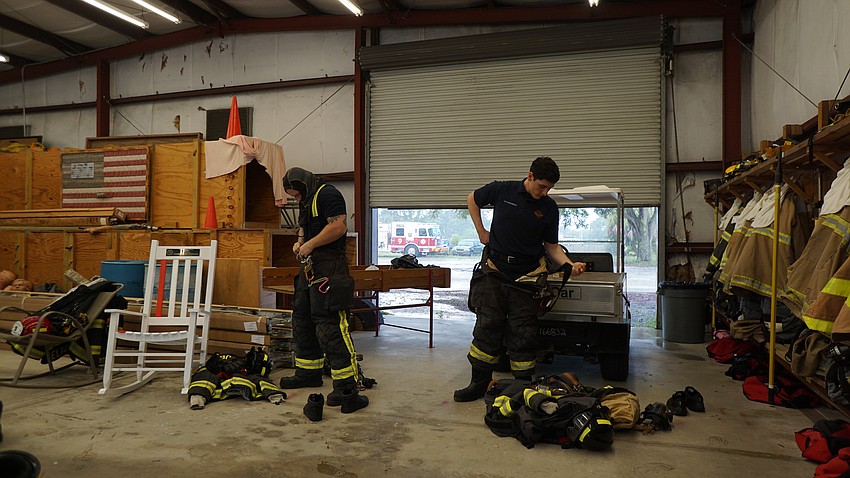- February 27, 2025
-
-
Loading

Loading

Outside, thunder shook the atmosphere, accompanied by a downpour of rain, but inside the training building of the Sarasota County Technical Institute Fire Academy, it was a completely different environment. And it was heating up.
“Alpha Team standing by,” called a voice over the radio.
When the training leader gave the team the green light, Alpha Team breached the bare living room scene in the training facility. Firefighters-in-training flooded the room in teams much larger than the pairs they would be in during a real-life scenario.
The couch was on fire.
One of the trainees took control of the hose and extinguished the fire before Alpha Team advanced to the kitchen fire.

With the touch of a button a control room, flames engulfed the ceiling of the training simulation kitchen. The trainees crouched down and looked up at the orange sea of fire. It was a simulated rollover — when a fire reaches a ceiling and then spreads horizontally.
In a rollover, the team needs to deploy a technique called “penciling,” where short bursts of water are applied to the ceiling to cool gases and prevent a larger ignition that would take over the entire room.
Though a majority of the team had little real-life experience, they made it through the drill in only a couple of minutes, despite a few technical difficulties in the control room.
In the simulation, temperatures reached as high as 300 to 400 degrees Fahrenheit, but that’s nowhere near what temperatures can reach in the real world, according to Josh Hirschy. Hirschy was the operator in the control room and is a firefighter with Charlotte County.
About 3 feet off the ground in a real fire, the temperature can reach 500 degrees, but the temperature goes well past 1,000 degrees near the ceiling, according to Longboat Key Training Captain John Elwood.
Because of a concept called thermal layering, the hottest area is closest to the ceiling. Prior to entering the drill, every person on both Alpha and Bravo teams had to enter the room while the stove in the kitchen was on fire. Every trainee took off one of their gloves and reached toward the ceiling to feel the heat stratification.
During the simulated building fire, Longboat Key Fire Rescue recruit Daniel Rosetta was one of the Alpha team members. His new coworker and fellow new recruit, Derek Flaim, was outside on Bravo Team, waiting for his turn in the drill.
The first training exercise Longboat Key’s new fire rescue recruits went through on Aug. 18 was practicing how to maneuver through tight spaces with obstacles.
This exercise was contained in a wooden structure, which had three lanes on the inside. The trainees would enter the one end with their back to the wall, using either a “swim” or a “dive” technique to breach the wall.

Once past the opening braced by two-by-fours, they needed to crawl through one of the lanes, each with its own obstacles. One of the lanes had makeshift wires to simulate gear getting caught on objects. Another lane had a surprise drop where the bottom fell through.
Elwood guided the new recruits along in the process. The first exercise of the day’s training was a microcosm of the entire training process.
“When they go through school, you learn how to crawl, then you learn how to walk and then you kind of work up to a jog,” Elwood said.
First, the trainees need to get accustomed to breathing with the self-contained breathing apparatus out in the open. Both Rosetta and Flaim already learned this part at the start of their training process.
The first trial of the confined space exercise was performed with just their gear on, without the breathing apparatus. Fire gear alone takes away some of their senses, Elwood said. For example, the thick gloves take away some dexterity, making it difficult to move their fingers.
Then, after a couple repetitions of the first step, Rosetta and Flaim put on the breathing apparatus and practiced with that.
The two were then ready to move on to the final trial. For this, Elwood attached a blackout face shield to Rosetta and Flaim’s masks.
“We start layering it with complexity,” Elwood said.

The face shield simulates what firefighters would be able to see while in an active fire. With the face shields on, they can barely see their hands in front of them.
Elwood said it’s hoped that the trainees will never find themselves in these tricky situations, but he said repetition is key in training. If they ever find themselves in this situation, hopefully some sort of instinct will kick in.
“The other thing you’re trying to control is your natural instinct of fight or flight,” Elwood said. “Your body is telling you when everything in this building is getting out and you’re going in, it’s an unnatural act.”
Training for a Longboat Key firefighter paramedic is not contained to one day.
New recruits start with an 80-hour orientation, according to Fire Chief Paul Dezzi. During orientation, they learn about the town, the department and get familiar with the equipment. New recruits also go through driver training and safety functional training, like at Sarasota County Technical Institute Fire Academy.
After the orientation hours, the trainees get placed on a shift and are assigned a preceptor. The preceptor is an experienced paramedic that acts as a field trainer for anywhere from 12 to 16 weeks. During this timeframe, the newbies learn about protocols for talking to a patient and best treatment practices.
Once both the preceptor and trainee feel confident, the department’s medical director is notified and gives a test composed of multiple scenarios. If the trainee passes the test, then they become a paramedic-in-charge.
Next comes the more rigid, on-the-job fire training. This process lasts for about two and a half years, during which the trainee is tested about every month on certain modules. After this is completed, the trainee graduates to become a fully trained firefighter paramedic for the town of Longboat Key — almost.
Though the formal training process is complete after that, every member of the department goes through routine training. This allows the department to stay up to date and always be learning new skills.
“When we get a call, the citizens are getting a high level of service,” Dezzi said.